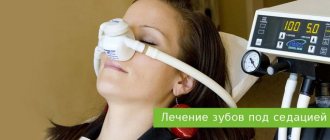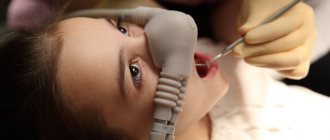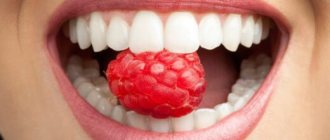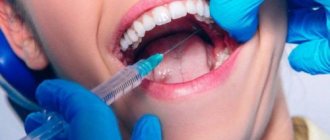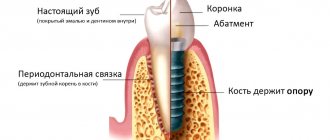The priority of modern scientific dentistry is the most painless and comfortable treatment, leaving only pleasant memories. But those patients who have been afraid of dentists since childhood are often recommended to undergo procedures under sedation.
Sedation (from the Latin sedatio - to calm down), or drug-induced sleep, is a condition in which the areas of the brain responsible for fear and anxiety are blocked: the patient falls into a light slumber. Consciousness is maintained, and the patient can follow the doctor’s instructions - for example, turn his head or open his mouth. Other centers of the brain that support breathing or coughing are not inhibited, and treatment in the oral cavity occurs safely.
Sedation is indicated for patients who are afraid of pain and discomfort. People who lead an active, stressful lifestyle often resort to dental treatment under sedation in Moscow - they often have a low pain threshold, their nervous system is easily excitable, and any dental procedures cause severe discomfort. Sedation can be intravenous or inhalational. With intravenous sedation, the drug is injected into a vein through a catheter, dosed very precisely, and the anesthesiologist monitors the patient's condition, administering an additional dose if necessary. Intravenous sedation itself does not provide pain relief, so local anesthesia is additionally administered. Intravenous sedation is performed only in adult patients. For mask or inhalation sedation, a mixture of nitrous oxide and oxygen is used. The use of this method may be justified, for example, in case of allergies to local anesthetics, but the most modern and frequently used method for adults is intravenous sedation.
No matter how attractive the idea of “dental treatment in your sleep” is, there are also contraindications :
- acute diseases of the upper respiratory tract, in which nasal breathing is difficult;
- mental illnesses accompanied by agitation or aggression;
- epilepsy;
- myasthenia gravis;
- pregnancy;
- age under 3 years.
High blood pressure, angina pectoris, traumatic brain injury, heart attacks or strokes in history are not an absolute contraindication, but consultation with a therapist, careful examination and monitoring of the condition during the procedure are required.
What is sedation?
Sedation is a process of relaxation and anxiety relief. The word itself comes from the Latin “sedatio”, which translates as “calm”. In dentistry, various sedatives are used for these purposes, which are administered by inhalation or intravenously. Thus, it is customary to distinguish several types of such anesthesia:
- inhalation sedation: for this direction we use the inert gas xenon, which does not anesthetize, but relaxes before introducing the main anesthesia (usually local, that is, infiltration or conduction, which allows you to anesthetize the tissues of the oral cavity).
- intravenous sedation: sedatives are administered through a catheter directly into a vein. The patient becomes drowsy (sleeping or dozing),
- general anesthesia: drugs are administered intravenously (inhalation is also possible, but this type of anesthesia is not used in dentistry). The person goes into medicated sleep for several hours.
Anesthesiologist Vera Indienko will tell you the difference between anesthesia and sedation.
You can often hear from patients or even doctors that sedation is an alternative to anesthesia; they present it as if there is a fundamental difference between sedation and anesthesia.
Therefore, let's start the article with definitions.
Sedation is one of the main components of anesthesia. This is what depresses consciousness.
For a more precise understanding, here are situations when a person is in a depressed state of consciousness:
- Physiological sleep
- Anesthesia
- Sedation
- For problems with the central nervous system (injuries, infections, etc.)
The reasons for this may be different, but the result, depression of consciousness, is almost the same.
Anesthesia is a drug-induced depression of consciousness, in other words, drug-induced sleep. Sedation is also a drug-induced sleep.
This condition is manageable, it can be superficial or deeper. The medications used for sedation (inhalation or intravenous) and anesthesia are the same.
When talking about manipulations in surgery, dentistry or research under sedation, we mean that the patient’s consciousness and protective reflexes (coughing and swallowing) are partially preserved; if necessary, he will be able to follow the doctor’s instructions, take the desired position, open his mouth wider, etc. .
But please note that staying at this level of consciousness does not allow us to carry out many manipulations and this is not possible with every patient. This sedation helps relieve anxiety and fears of medical intervention.
In what cases is it possible to use sedation with partially preserved consciousness:
1. Oxygen sedation in dentistry (performed by a dentist, but just in case an anesthesiologist should be present at the clinic)
2. Intravenous sedation in dentistry (can be used in adults and in some cases in adolescents)
3. Intravenous sedation during any operation where pain relief is provided using regional anesthesia (also suitable for children, but much less common than in adults).
Intravenous sedation during endoscopy (gastroscopy, colonoscopy) is deep sedation, the patient is completely asleep and it is more correct to call it “intravenous anesthesia.”
As the dosage of sedatives increases, sedation becomes deeper and then anesthesia.
Sometimes the anesthesiologist has to refuse sedation and perform anesthesia; in this situation, it is important to ensure the patient's airway is patent. The approach to this during sedation, when the patient is partially conscious, and during anesthesia is completely different. We will devote a separate article to this.
How is intravenous sedation different from general anesthesia?
The main difference is in the drugs used. As a consequence - in the duration of medicated sleep, the quality and effect of anesthesia, the severity of side effects and consequences, as well as in the subsequent rehabilitation of the patient.
- number of drugs: with intravenous sedation, only one drug is used, and it can be in different dosages (and, of course, is selected strictly individually based on the results of in-depth diagnostics). The patient will be in medicated sleep during the entire period of the operation, or in a relaxed state, half asleep. With general anesthesia, 2 or more drugs are used, including tranquilizers and narcotics, which puts a greater burden on the body,
- anesthetic and analgesic effects: during general anesthesia all receptors are “switched off”, during sedation - partially, which occurs due to a decrease in general sensitivity,
- consequences: after general anesthesia, side effects may appear within 2-3 days after surgery. This is not just dizziness and confusion, but also lethargy and even hallucinations. With sedation, there is no need for hospitalization or a long stay in the clinic - complete recovery occurs within 1-2 hours. All side effects are short-term and mild.
Cons of sedation
But the procedure has significantly more disadvantages:
- The patient must be under the supervision of a physician for at least 1 hour after sedation. Therefore, in dental clinics where there is an appropriate office, there is also a ward in which a person is observed after procedures;
- On average, the cost of the procedure is about 15-20 thousand rubles. This is due to the high cost of equipment, consumables, duration of sedation and the need for observation after relaxation. For most residents of Russian regions, 15-20 thousand rubles per procedure is expensive;
- Before sedation, you must undergo tests and consult an anesthesiologist. This is required to eliminate any risks associated with being in a state of relaxation;
- Sedation is not a substitute for anesthesia.
In addition, due to the relaxed state and delayed reaction, the patient will not be able to quickly report increased pain or changes in sensations.
Which is better, sedation or general anesthesia?
Intravenous sedation is carried out using lighter and simpler drugs, so it is the more preferable method of pain relief when carrying out large-scale work. And not only in dentistry, but also in many other branches of medicine. Fewer side effects, including prolonged action (with general anesthesia, they can appear even within a year after treatment), less stress on the liver, kidneys, cardiovascular and nervous system.
In general, the advantages of intravenous sedation are as follows:
- you fall asleep - you don’t feel pain, you don’t see how treatment or surgical procedures are carried out, and what instruments the doctor uses (and all this causes extreme stress for those who are afraid of the dentist),
- all treatment is carried out at one time, which is especially important in case of multiple scattered caries or in case of total restoration of teeth on implants,
- the quality of treatment improves and the risk of postoperative complications decreases, since the doctor is not distracted by the patient’s emotions,
- It is possible to carry out treatment in patients who are not affected by classical “freezing” or have allergic reactions to the drugs used.
With us you will stop being afraid of dentists! Individual selection of drugs, the most modern equipment and certified doctors who professionally work with all types of anesthesia.
Enroll now
Advantages of dental treatment under sedation
This method allows you to carry out a large amount of work at once, which without sedation can be difficult even for adults and patient patients who are not afraid of treatment. Many complex procedures, such as wisdom tooth removal or the installation of several implants at once, can be performed under sedation in one go. Sedation is also recommended for patients with allergies to local anesthetics used in dentistry - in this case, a mask with nitrous oxide, which has an analgesic effect, is used.
At the same time, sedation, unlike conventional local anesthesia, requires a more thorough approach. If a patient (or the parents of a small patient) wants to undergo dental treatment under sedation, an anesthesiologist is involved in the work - it is within his competence that a preliminary examination and the choice of drug are carried out. Before the procedure, it will be necessary to exclude the presence of contraindications and allergies, do an electrocardiogram and take blood tests.
Accordingly, not every clinic can provide dental treatment under sedation for children and adults - for this, the medical institution needs special equipment, a license for this type of medical care such as anesthesia, as well as a highly qualified anesthesiologist on staff.
How is treatment performed under intravenous sedation?
The essence of using intravenous sedation is that certain anesthetics are introduced into the body, which put the person into sleep. The drug itself and its dosage are selected based on the patient’s weight, health status, and the duration of the procedure. If necessary, the drug can be reintroduced during surgery.
A catheter is inserted into a vein in the arm through which the medication is administered. The catheter remains in place until the end of the entire treatment, as repeated administration of the drug may be required.
The operation is performed on an empty stomach: you cannot eat or drink for 6 hours before sedation. The procedure is not limited in time. The patient wakes up naturally within 20 minutes after the end of the drug and is under the supervision of specialists for a maximum of 1-2 hours who will monitor their health.
After treatment under sedation, it is strictly not recommended to drive, as concentration decreases. There are no more restrictions.
Features of tooth extraction under anesthesia
Anesthesia for tooth extraction is no different from that used for other types of dental procedures. Indications and contraindications remain the same, as can be said about the technique.
At the same time, we note that the use of anesthesia to remove one tooth is not always considered appropriate, since there are less radical and no less effective methods of pain relief.
Doctors will advise you on all issues, develop an individual treatment plan based on the characteristics of your specific clinical situation, and also agree on all the nuances of subsequent work.
How will you feel?
Nothing, because sedation relieves all unpleasant sensations. At the same time, it can be superficial - you will be in a state of half-asleep or half-asleep (answering doctors’ questions, periodically falling asleep, but remaining in a relaxed state), or complete, when you will be sleeping throughout the entire time the operation lasts . Here the choice is yours. But in both cases you will not feel anything. The maximum is the “moving” of the instruments in the oral cavity, because you understand that the doctor is doing some kind of work.
Comfortable treatment without pain! We carry out thorough diagnostics, select medications and dosages strictly individually. It's safe here!
Enroll now
How exactly does sedation occur in dentistry for children and adults?
There are various sedative drugs. For adults, they are most often administered intravenously, and for pediatric dentistry with sedation, nitrous oxide is used - oxygen sedation: a special nasal mask is put on, the child breathes through it and goes into a state of sleep. In fact, from a physiological point of view, nitrous oxide, an oxygen mixture, is not sedation as such, but the effect obtained when using it is similar to sedation. The difference is that with ZACS there is no depression of consciousness at all, which is even more convenient for the doctor. But you need to take into account that if the baby is already hysterical, sedation will not calm him down, but will only worsen the situation. Since the child remains fully conscious, he will most likely remember absolutely everything, but at the same time his level of tolerance will increase, and he will be more likely to be distracted by the cartoon that will be shown to him during the procedure. The use of nitrous oxide increases the period of time during which a small patient is ready to endure unpleasant manipulations, but does not cause either a suppressive or euphoric effect, that is, it is an absolutely safe procedure. The most important advantage of this method is the ability to communicate with the child, that is, complete control of the situation by the doctor.
Will it hurt during and after treatment?
No, there won't be any pain either. 1-2 hours after treatment, when the anesthesia wears off, tolerable pain may occur. It is associated exclusively with tissue injury. The doctor will prescribe painkillers for you: whether to take them or not is up to you to decide, based on your own condition. More than half of our patients after dental implantation take painkillers only for the sake of prevention - so that the pain does not overtake them in the middle of the night while sleeping, about 30% do not take them at all, and the rest do not take them as prescribed, because there is slight discomfort.
What if something goes wrong? Is this really safe?
Yes, it is completely safe: the administration of the anesthetic, as well as monitoring the patient’s condition, is carried out by professional and licensed anesthesiologists. The participation of professional anesthesiologists in the operation who monitor the patient’s condition allows the implant surgeon or maxillofacial surgeon at our clinic to fully concentrate on the operation. Constant monitoring of all vital indicators of the patient’s health status is mandatory.
In addition, there is an ambulance station in close proximity (up to 1 km) from each clinic. And this is an additional guarantee of your safety, because in case of complications, every second will count.
“Like you, we are sincerely interested in safe treatment and high-quality restoration of your health, so we make every effort to provide comfortable treatment: we focus on diagnosis, the correct selection of medications, and monitoring the condition during surgery.”
Namdakov Nikolay Vladimirovich maxillofacial surgeon, implantologist, orthopedist, work experience over 18 years make an appointment
Contraindications
Despite its apparent safety, sedation is not indicated for all categories of patients. Below is a list of who may benefit from local anesthesia only:
- small children under 3 years old. Due to their age, they cannot describe their feelings and condition;
- patients with respiratory diseases. Breathing may be impaired;
- pregnant women. There is concern that exposure to the gas will negatively affect the fetus. This is especially true for the first and third trimesters;
- patients with epilepsy. The gas can trigger an attack;
- people who have recently suffered a traumatic brain injury. Increased intracranial pressure may worsen the condition;
- patients with mental disorders. Their inadequate reaction can interfere with the smooth conduct of dental treatment.
What do patients say about treatment under sedation?
Most of our patients sleep during surgery and wake up after the doctor has finished treatment. Many people note that they sleep well during this time. If they remain conscious (lighter sedatives are used), then they do not feel pain, but there is a feeling of a slight “crawling” in the mouth from the knowledge that the doctor is removing/treating teeth or implanting implants.
Svetlana Yurievna
“They sat me at a table, put me on an IV, then transferred me to a chair and I don’t remember anything else. Before the operation, the doctor noted that he would look at my condition and see how much medication I would need. To be honest, this scared me. Because I thought that at some point the sedative would end, it would hurt and I would feel it. But nothing like that happened, I turned my head - they put additional medicine in my IV, and everything ended well. I am immensely happy!”
- treatment WITHOUT FEAR and pain
- guaranteed safety
- minimal health risks
- with condition monitoring and professional supervision
watch a video with the patient
How to prepare for treatment
To ensure that sedation does not have any negative effects on the patient’s body, a thorough diagnosis of the health status before it is necessary - it will allow you to exclude possible contraindications, choose medications, and also find out what difficulties may arise during medicated sleep.
Tests and examinations before treatment under sedation
Before treatment or dental restoration under anesthesia, you will need to take a number of tests and undergo some examinations. You can take tests directly in our clinics completely free of charge: they are included in all types of dental implantation.
- general and biochemical blood test (AST, ALT, urea, creatinine, total protein, glucose, electrolytes), valid for 14 days,
- blood test for HIV, hepatitis C and B, syphilis, blood group and Rh factor, valid for 3 months,
- hemostasiogram or coagulogram (blood test), valid for 1 month.
All of the above tests are performed directly in our clinics completely free of charge. It is also additionally necessary to provide the results of the following examinations:
- ECG (electrocardiogram),
- Chest x-ray or fluorography – research results for the last 6 months are accepted: images or a specialist’s opinion (description of the images),
- For patients over 50 years of age, consult a general practitioner or cardiologist.
In a number of laboratories, these tests can be performed in a comprehensive manner: medical companies are developing special profiles called “hospital” profiles, in particular “for hospitalization in a surgical hospital.”
Lifestyle before treatment under sedation
- the operation is carried out without signs of acute respiratory viral infections and other infections. If you feel sick or become ill, be sure to notify your personal manager to reschedule your surgery,
- food: on the day before surgery, a light breakfast is allowed: dry toast, tea or weak coffee without milk. If the operation is in the morning, then you need to limit yourself to dinner only,
Important! Before surgery, under sedation, you cannot eat for 6 hours!
- drinks: stop drinking liquids 2 hours before surgery,
- alcohol: prohibited 2-3 days before surgery,
- taking medications: orally – no later than 2 hours before surgery,
- women are advised not to use cosmetics and must also remove all coating from their nails,
- After the operation, we do not recommend driving, so you must come to the clinic by taxi/public transport or ask someone you know to bring you.
Follow the link to study a detailed reminder about preparing for implantation.
Specifics of treatment for special children
Sedation is not recommended for adolescents with autism, cerebral palsy, or Down syndrome. Firstly, it is, in principle, difficult to establish verbal contact with them, so this factor is not relevant for the doctor. Secondly, the nuances of the mental development of special children indicate the undesirability of such outside interventions. Thirdly, dental treatment usually takes a long time, since it involves the treatment of an impressive number of elements. This is associated with possible injuries to soft and hard tissues, which are extremely painful. Therefore, it is better to replace sedation with traditional deep anesthesia.
At the same time, there are alternative methods that allow you to find a reasonable compromise between general anesthesia and sedative sleep. First of all, these include various types of hypnotic influence. Theoretically, hypnosis does an excellent job of reducing sensitivity and relieving the patient of pain. However, in practice this is not easy to achieve. Children who respond well to sedation are almost not susceptible to hypnotic effects. It is almost impossible to introduce a child into a state of true Ericksonian hypnosis. Therefore, in today's dentistry this method is actually not used.
NEED TO KNOW! No special preparation is required for dental treatment under sedation. However, it is worth observing the general wishes regarding visiting a dental clinic. There is no need to eat for a few hours before your visit to the dentist. At the same time, it is undesirable to carry out the intervention on an empty stomach, so you need to get up early and have a hearty breakfast. It is better to carry out treatment in the first half of the day: muscle tone and psycho-emotional background of a person before lunch are favorable for surgical manipulations. Under no circumstances should you go to the doctor under the influence of alcohol or drugs: this will not relieve fear, but can sharply increase the negative consequences.
Are there any disadvantages to sedation?
Naturally, dental treatment or implantation under general anesthesia has certain disadvantages. In particular, the need for rehabilitation after the administration of the drug and a fairly large list of contraindications. However, our clinic conducts a thorough diagnosis of the body’s condition before using any anesthetics. If the doctor identifies certain risks, you will be denied sedation and will not take any risks. In addition, by working with professional anesthesiologists, any unpleasant consequences are reduced to a minimum.
Sedation for children
This method of dental treatment is also used in pediatric dentistry. Sedation is the only way to properly treat a small child’s teeth. The inhalation method is considered the most preferable. A pediatric oxygen mask is used. Children will be offered to try on a beautiful mask that smells pleasantly of fruit. Treatment is recommended for children from 3 years of age.
- Providing assistance in dental treatment for hypermobile children.
- Possibility to treat very young children who are afraid of the treatment procedure.
- Minimum short time of effect of sedation on the nervous system.
- Rapid elimination of the sedative agent by exhalation of the child.
In case of ENT diseases, adenoids, difficulty in nasal breathing and the presence of chronic diseases, the use of a sedative mask is not recommended. Contraindications are identified by a pediatrician. He must examine the child before the sedation procedure begins.
